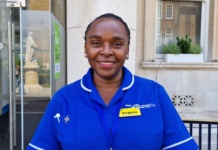The struggle to survive pregnancy and death in a land of plenty and poverty hasn’t changed much in the past five years — there are lives to prove it.
 Busisiwe lives in an isolated homestead in rural KwaZulu-Natal. When Amnesty International met her and her baby daughter and family more than five years ago, they were – like many South Africans – surviving on social grants. This despite the fact that Busisiwe, as we called her and who was then 18, had not been able to access one for her daughter.
Busisiwe lives in an isolated homestead in rural KwaZulu-Natal. When Amnesty International met her and her baby daughter and family more than five years ago, they were – like many South Africans – surviving on social grants. This despite the fact that Busisiwe, as we called her and who was then 18, had not been able to access one for her daughter.
She told our researchers then that she felt too ashamed as a young mother to face the civil servants at the payment office.
When she was four months pregnant, Busisiwe went to the antenatal clinic because she wanted to know whether she was HIV positive so that, if she was, she could get the antiretroviral medication needed to prevent transmission of the virus to her baby.
She walked to the clinic, a journey that takes between 60 and 90 minutes each way. When she arrived, healthcare workers insulted her publicly.
“They started to shout: ‘Why are you pregnant? You are so young,'” she remembered.
“Every time [I went] they were shouting, saying: ‘Your mother sent you to school and you are going to look [at] boys?'”
Frightened, Busisiwe left the clinic without being screened for HIV.
Watch: This is what happened when Bhekisisa called one clinic to ask about abortion
Instead, Busisiwe tested four months later through an NGO at her school where she says she was treated better.
But she didn’t take her result to the clinic.
She explained: “I dislike them, the way they treat me.”
Busisiwe was one of hundreds of women in Mpumalanga and KwaZulu-Natal whom we interviewed in 2014 to uncover why the country’s maternal mortality remained stubbornly high, especially among women living with HIV.
With about 141 women dying for every 100 000 live births in the country, too many women and girls were dying needlessly during pregnancy or labour or shortly after, according to Statistics South Africa’s 2013 figures.
Our report unearthed three major barriers to the kind of adequate antenatal care needed to prevent these deaths.
The first was a lack of privacy and informed consent, especially about HIV testing. Many of the women and girls interviewed by Amnesty International said that their fears about lack of privacy and patient confidentiality in facilities put them off visiting their local clinic for sexual and reproductive health services and antenatal care.
In addition, pregnant women and girls feared that, if they refused an HIV test, they would be denied other antenatal care services.
“Testing was not optional, it was compulsory … if you didn’t test, you didn’t have antenatal classes. Everyone had to go through the tests,” one KwaZulu-Natal woman told us
We also found that healthcare workers lacked information and training about sexual and reproductive health and rights. To boot, all 16 health facilities we visited then had either a shortage or total lack of printed information on contraceptives, abortion or antenatal care – much to healthcare workers’ disappointment.
Finally, our report revealed a dearth of affordable, available transport to and from health facilities for pregnant women.
When Busisiwe went into labour, she had to ask a neighbour to drive her to the hospital as she didn’t have the R250 it would cost to hire private transport.
The neighbour took her only as far as the nearest clinic, where staff called an ambulance.
“I was feeling very worried and in pain but no one attended [to] me … [healthcare workers] showed me one of the beds and they said I must wait there for the ambulance and they left me there,” she told us.
“They didn’t come back again until the ambulance arrived.”
Busisiwe explained that, because of how she had been treated at the clinic during the antenatal care visits, she was scared and didn’t feel able to ask for help while she was in labour.
Emergency medical services took three hours to arrive.
Read more: Where are all of South Africa’s ambulances?
Four years on, the latest audit of maternal deaths in the country has found that many of these barriers remain. The report, which tracked maternal deaths between 2014 and 2016, has again found the lack of antenatal care to be a key contributory factor in preventable maternal deaths.
Almost 3 700 women and girls are reported to have died of pregnancy-related causes during this period. Almost a quarter of the deaths were linked to late or no antenatal care.
A Mpumalanga healthcare worker who did not want to be named recently told us that transport remains one of the biggest challenges women face.
Ambulances often arrive late, especially in rural areas, which can result in grave complications for the women giving birth.
But some things have improved since Amnesty’s 2014 “Struggle for Maternal Health” report.
Currently, the South African government recommends that women and girls begin their antenatal care visits from 14 weeks into their pregnancies.
Appointments are free of charge and, in April 2017, the government increased the number of recommended appointments from four to eight.
Although a third of them won’t seek care until after 20 weeks or about midway through their pregnancy, the World Health Organisation says three out of four pregnant women go for at least four visits. As a result, the number of maternal deaths has reduced significantly since 2011, the latest maternal death audit shows.
In KwaZulu-Natal, the situation at one of the rural communities we visited in 2014, uThungulu district municipality, is also slightly better. Women in the area can now use state patient transport to take them to the hospital from their local healthcare facility for appointments. But an NGO volunteer says the service only runs on specific days.
It’s an improvement from four years ago, she said, but ambulances are still unreliable.
“If you call an ambulance now in the late afternoon, it will only come tomorrow morning,” she explained.
Despite Busisiwe’s ordeal and lack of adequate treatment, she eventually gave birth to a healthy baby but the obstacles she encountered are still faced by pregnant women and girls and are underpinned by one important factor – gender inequality.
The challenge is even greater for the women and girls who want to terminate their pregnancies because services are only offered by 7% of South Africa’s 3 880 health facilities, a 2017 Amnesty review of government-listed facilities found.
Evidence about the barriers to maternal health and safe and legal abortion was part of Amnesty International’s submission at a United Nations review of South Africa’s progress in fulfilling the International Covenant on Economic, Social and Cultural Rights late last year.
The committee recommended that South Africa improve sexual and reproductive health services to ensure that care is accessible to all, particularly in rural areas. It also called for the National Health Insurance (NHI) to be expedited in order to address these inequalities. Quality, equitable healthcare is not only important for communities, it also ensures that women, including those living with HIV, have access to the medical attention and knowledge they need.
The NHI must deliver adequate health cover, especially on reproductive health, for all pregnant women and girls.
Shenilla Mohamed is the executive director of Amnesty International.
Kindly follow us on twitter:@AfricanVoice2









